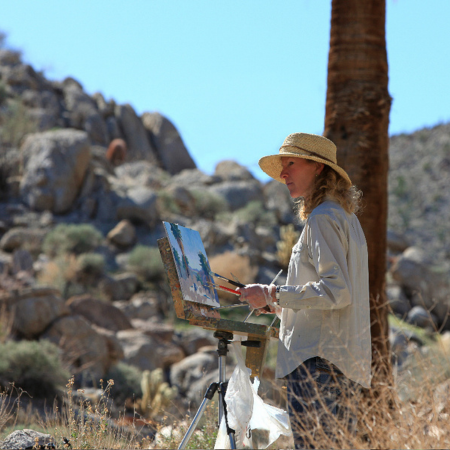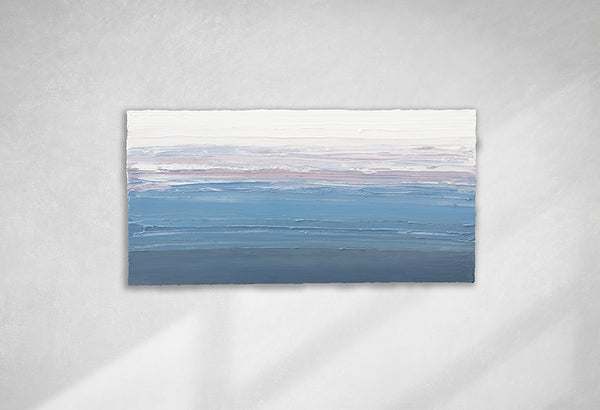This month, we sat down with Colorado-based artist Kay Flierl to discuss the ins and outs of her artist practice and get a glimpse inside her Denver studio space. Flierl's work spans both abstracted and more realistic styles and captures anything from botanical studies to coastal or rural scenes. Read our talk with Kay, where we dive in to her creative process, her evolution as an artist, the challenges she faces when painting, and much more.
Our Interview with Kay Flierl
Where are you from originally?
I was born in Wisconsin with farms and lakes all around. At the age of 11, my dad’s career took our family to Colorado. My husband and I met at Colorado State University, married after graduating and then he and I and our two children moved back and forth between Denver, southern California and Atlanta, GA. We bounced back and forth between two coasts, but I found it valuable as it gave me an exposure to different parts of the country with a variety of environments and cultures.
How did you get started as an artist, and with your current style/medium?
Working as a graphic designer for twenty years provided me a creative outlet, but I always had an unrelenting desire to paint. Just prior to turning 40 I decided to teach myself through books and a few workshops. Not long after, I found myself in an emergency room diagnosed with late Stage 3 Non-Hodgkins Lymphoma. The painting mission that I began just shortly prior became my therapy during chemotherapy and thereafter. It was a gift from God that got me through a tough time. Friends began to compliment my work so I sought out an interior designer to give her opinion. Coincidentally, she was opening a retail store and offered to put my work on consignment in the store. It blossomed organically from there with galleries reaching out to offer representation as time went on.
Although I began painting abstract works in acrylic, our move to Newport Beach, CA in 2006 catapulted me into the world of plein air painting. It was all around me with close proximity to Laguna, so I studied under many of the country’s best plein air painters. It was such a prolific, supportive artist community where we painted alongside one another and participated in numerous workshops, shows, competitions and art associations. As a result, my initial abstract body of work was then complimented by a more representational body of work. I have continued both styles to the present using a combination of acrylic and oil.

Can you describe your creative process?
I spend a lot of time outdoors on road trips, hiking, walking, biking and working in the garden so nature and meditation are the initial inspiration to what eventually finds its way onto the canvas. I also gain inspiration through other art forms…photography, graphic design, architecture and interior design.
I typically work on one piece at a time because I am emotionally invested in each painting. I like to work a piece through to the end so I can then clean the slate of my mind to take in something new. But I also recognize when I hit an impasse within the process and say to myself, "Okay, this piece needs to be set aside until I’m ready to tackle it in a new light." I trust myself to know that I will eventually find a resolution.
I enjoy the immediacy of fast drying acrylics and use that for the first initial, often frenetic layer or two. I then add additional layers in oil and oil stick as I slow down the process and put more thought into the final composition. I’m usually listening to music, podcasts or the birds singing.

Some pieces just fly onto the canvas in a flow that feels very spiritual. Those are precious pieces to me because I barely even think about what I’m doing. And there is very little, if any struggle. I also very much enjoy the meditative state of creating where I talk to God and analyze life and decisions or just immerse myself in the process itself. It’s a very therapeutic endeavor.
I’ve found I have an endless desire to paint the next painting, so I am also rewarded by fulfillment in what I do. And of course, I am humbly validated that another person would be so moved to purchase something I’ve created.
What’s the most challenging part?
I went through many years of internal struggle trying to determine if I should focus on an abstract or representational body of work. I felt the industry demanded that I make a choice. But I couldn’t hone in on one and so I continue to paint what my heart dictates which is both. So far, it is working.
Where and when do you do your best work?
Mid-morning to late afternoon most days of the week. I work from a studio we built in our backyard. It’s amazingly convenient. For plein air painting, my favorite time is the golden hour…about 4-7pm when the colors intensify and shadows are at their longest. It’s a magical time period.

Yes. Although on the surface they appear to look unrelated, I do think they inform one another. For me, a common thread is that everything has a poignant and fragile cycle of life with all of its precious moments. Throughout that cycle, beauty is not a given or a constant and usually only reveals itself through struggle. Everything flows in and out of cycles of beauty and chaos. I think my style represents that through the use of energetic areas of brushwork balanced by quiet, peaceful areas. I’ve chosen forms that have significance to me…people, nature, and barns.
For many years I did struggle internally over having multiple, seemingly disparate bodies of work. But over time, I just listened to my heart and found it proved to provide more diversity for representation in different galleries. I am rewarded by the fact that it keeps me inspired and fresh in my technique and subject matter.

Where does the inspiration behind the floral abstract work come from?
My love of nature. But a significant memory of my childhood was time spent every summer at the lakes in northern Wisconsin. I am one of five kids so the vacations we could afford were road trips. I remember walking along the bank of the lake and loved how the tree roots forced their way above the sand to create “steps” along the pathway. I would sit beneath the trees with leaves overhead and dappled sunlight on the water below. I am still mesmerized today by trees overhanging the water and the sound of water lapping against the shore.
Your coastal scenes often include figures. Are there any specific challenges in trying to capture people in this type of setting when you’re looking for references?
Having lived in multiple places, I’ve photographed everything from farms to mountains to beaches. With 16 years in Newport Beach, CA, I not only often painted on the beach, but also built up quite a catalog of photos. It’s the easiest place to find every form of the human body. Plus, people are content to sit.
From your first painting to those you create now, has your work overall changed? If so, in what way(s)?
Initially I was strictly abstract, but then I settled in on a combination of representational and non-representational subject matter. What changed more significantly is the confidence level in how I approach the canvas. I try not to get too wrapped up in my head.

Are there any particular artists who have inspired you or to whom you feel connected in some way?
Oh, so many, for different reasons. Historical: Wolf Kahn, Joaquin Sorolla, Berthe Morisot. Current: Ingrid Christensen, Luis Garcia Nerey, Ben Bauer, Quang Ho, Marcia Burtt. I love watching how other artists change throughout their career.
If you could give one piece of advice to your younger self as an artist, what would it be?
Go for it. You have a voice that’s worth listening to, so hone the talent God gave you and do what you love.
What is your goal as an artist? Is there any particular message you want to send to viewers or collectors?
My goal is to never lose a grateful heart for the ability to paint. 20+ years later, I am so thankful to every single person who purchased a painting and allowed me to continue to do what I love. And I hope that people continue to support galleries. Most artists prefer to paint rather than sell their work.
Now for something different: Are you a morning person or night person?
Morning. I enjoy the peaceful, fresh beginning.
Cats or dogs?
Dogs…amazing creatures of love.
Coffee or tea?
Coffee, but more importantly, bakery to go with it.
Warm weather or cold weather?
Definitely warm, but I like both. I just wish winters were shorter.
If you could be any animal, what would you be?
I aspire to love unconditionally like dogs do. A bird would be awesome too.
What’s your favorite place on earth?
Everywhere has something to offer, so I am just as happy to drive somewhere as I am to venture to another country. I love it all. I recently became a dual citizen of Luxembourg through my heritage so that is a destination on my bucket list. It’s a founding member of the EU, very rural, full of gardens and a foodie paradise.
To see Kay's full collection of original paintings, visit her Artist Collection. You can also click below to watch our live Q&A with Kay from Thursday, April 11, 2024.




0 comments
Post a comment